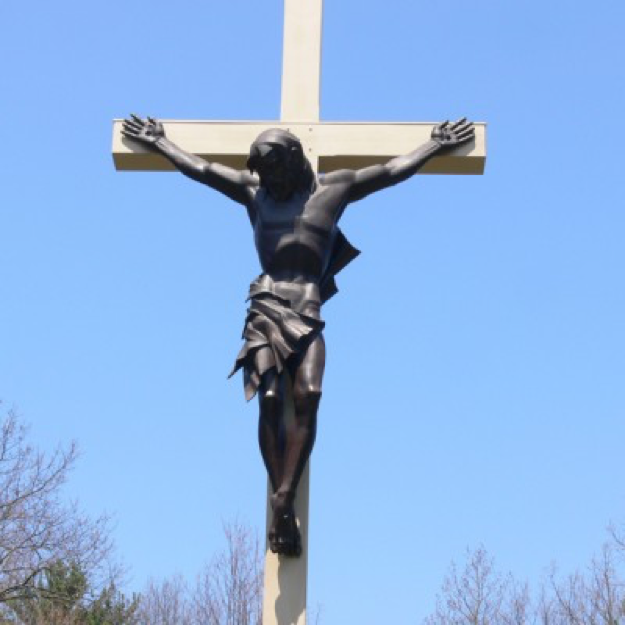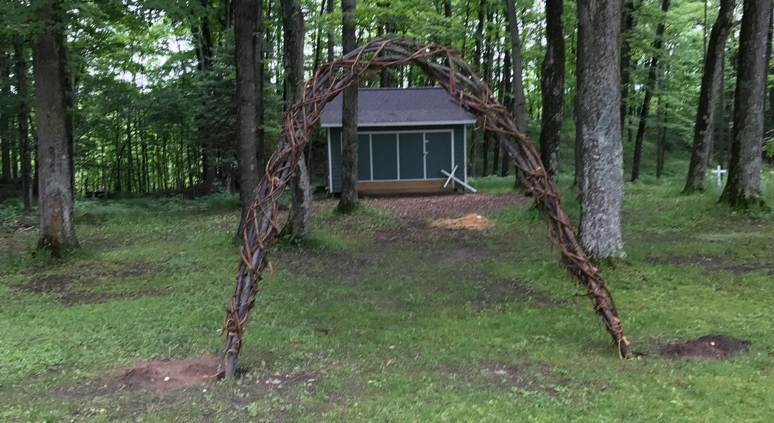The Largest Crucifix in the World: Is This What We Need?
I just don’t know how I feel about this. What do you think?

On a recent vacation, I couldn’t resist visiting what is billed as “the largest crucifix in the world” in the national shrine of The Cross in the Woods in Indian River, Michigan. (And what did you do on your summer vacation? Not visit huge crucifixes?) Here’s what they say about the crucifix”: “55 feet tall and 22 feet wide – is carved from a single redwood tree and stands as the centerpiece of this Catholic shrine in the woods of northern Michigan. The bronze figure of Jesus Christ that is attached to the cross weighs about 14,000 pounds and is the work of famous sculptor Marshall Fredericks…More than 300,000 visitors stop at the shrine every year.”
Oh, and it also mentions this. The Bishop of the Diocese of Grand Rapids started searching for land upon which he could establish a new church which went on for several years. “Finally, in May 1948, the parish was given the land for $1.00 and a box of candy for the secretary.” Can’t resist a little condescension no matter what the circumstances!
I had meant to use this enormous crucifix, and all it entailed to create it, to highlight yet another example of the power-obsessed having to have the biggest everything, including, stereotypically (and perhaps unfairly) with males, the biggest you-know-what. I was also going to rail against the cutting down of a huge redwood when we need so desperately to preserve nature, against the ubiquitous signs pointing to a gift shop stuffed with Catholic paraphernalia, against the amount of beautiful woods that must have been sacrificed to create the massive indoor and outdoor seating, not to mention the huge steel and concrete man-made hill on which the crucifix stands, covered with dirt so it would at least appear natural.
I was also going to bemoan the crucifix itself, so Catholic in its focus on sin, suffering and death in life’s journey rather than on resurrection and renewal.
But I found myself conflicted about all of that possible railing. I had to admit there was something about such a huge representation of suffering looming over me that pierced my heart with the God-is-with-us-in-our-deepest-pain message. Given the suffering those affected by recent mass shootings, immigrants confined in border detention or traveling to gain asylum or war ravaged or hungry or ill or grieving people, the symbol of agony before me actually seemed too small. I want a new church infused with the gifts of all genders leading the world into new harmony, peace, creativity, celebration, but I need some of the old, too.
And I was conflicted about the human-made beauty created within and by the woods. I feel the same about cathedrals and churches and shrines around the world. I traveled with a friend to see great cathedrals in France and Italy who said the thought of the amount of treasure, not to mention lives and lands lost, to create these greatly reduced her ability to appreciate them. I was, on the other hand, overwhelmingly grateful to the Church for having inspired and preserved such breathtaking art, such magnificence.
In nearby Charlevoix, Michigan is another “Church in the Woods,” this one an old native American site, now a small Methodist community. Notice the arched welcome. Notice the small, tilted white cross. Maybe, to build again, we need to start with the beginnings.

